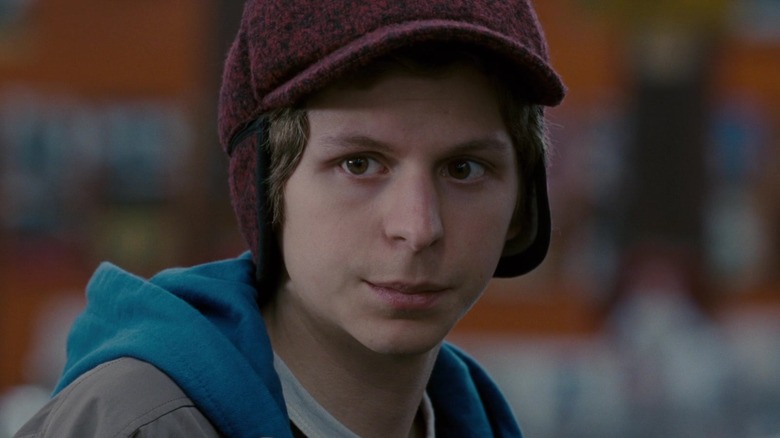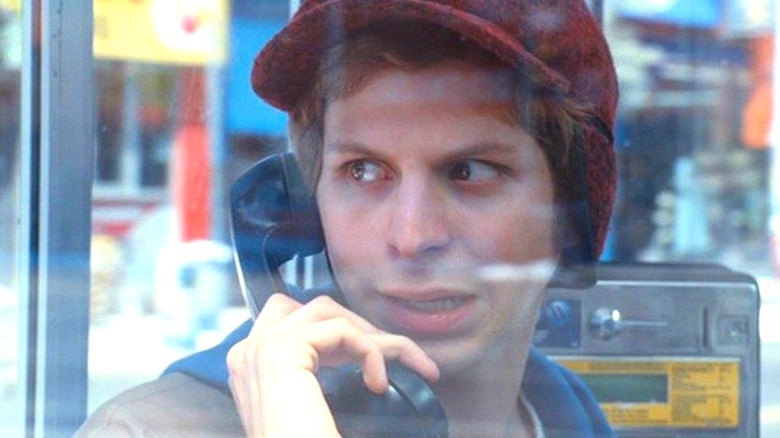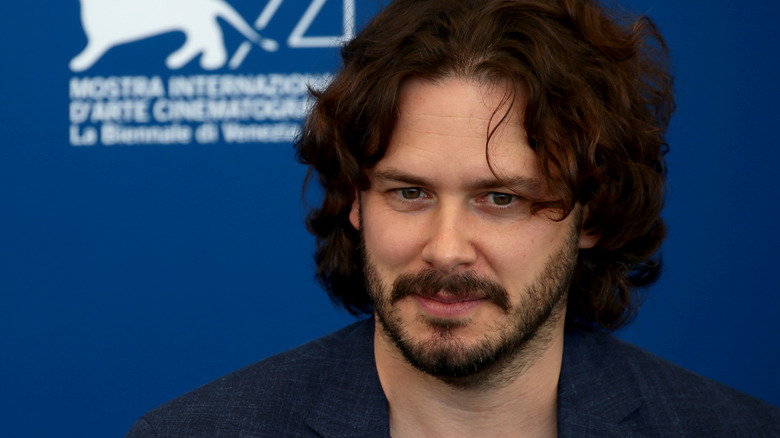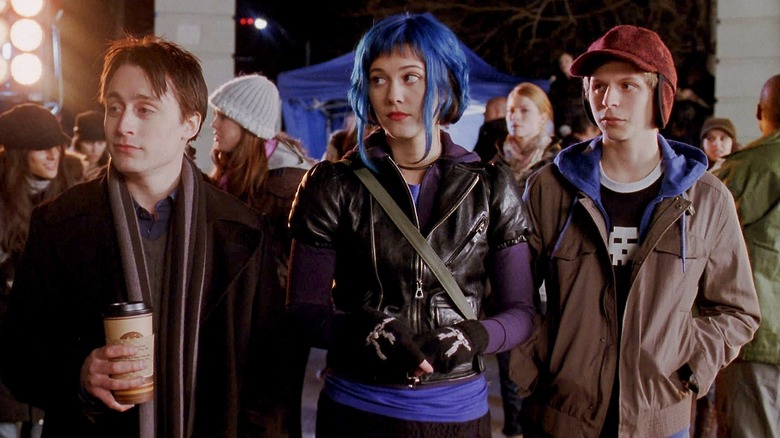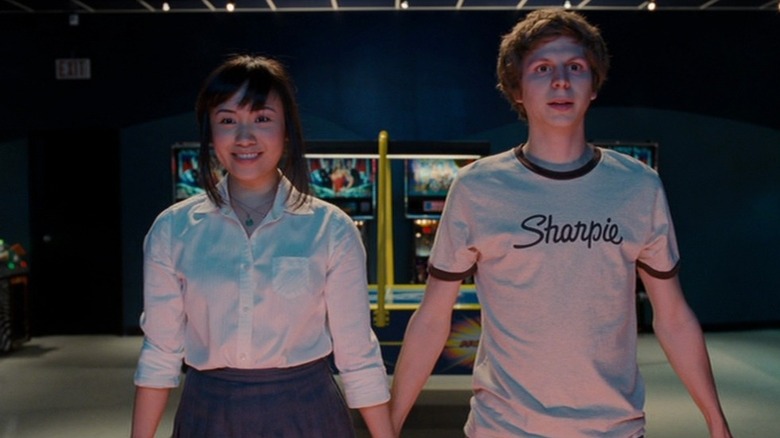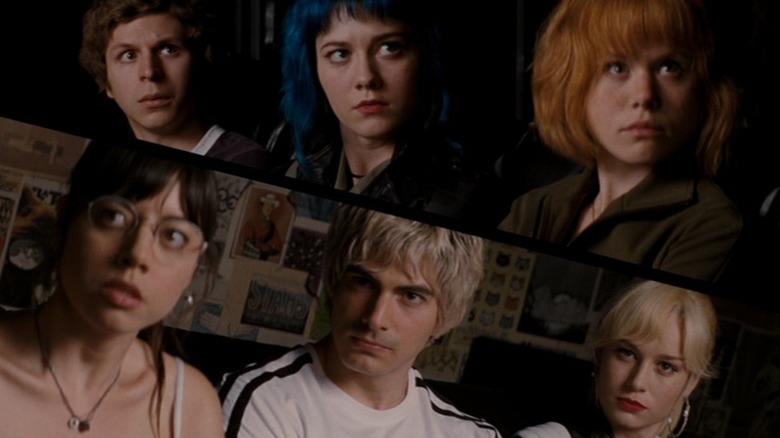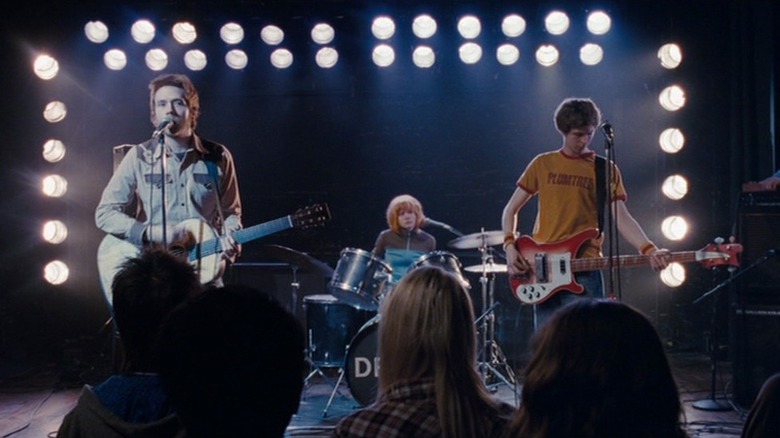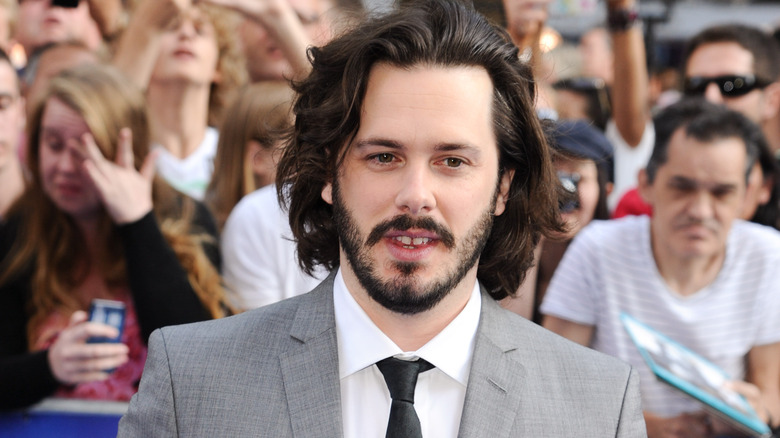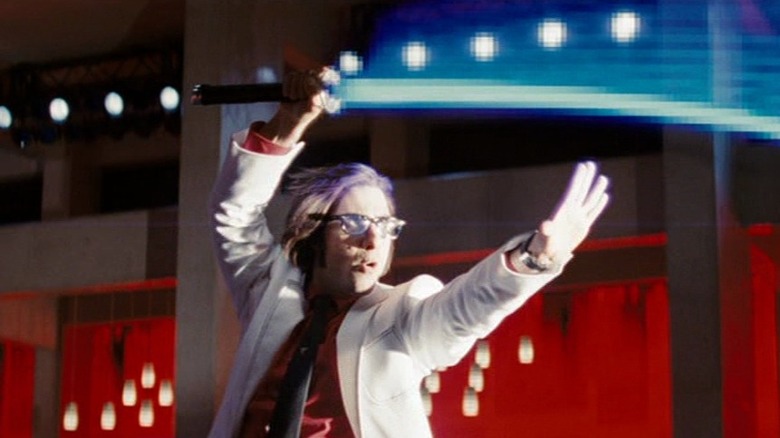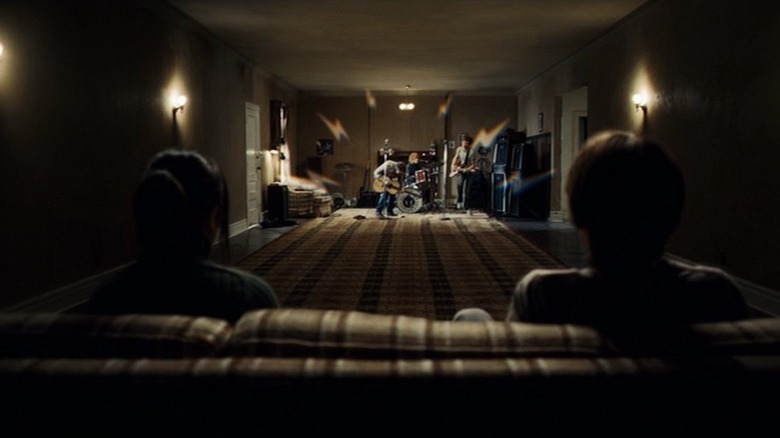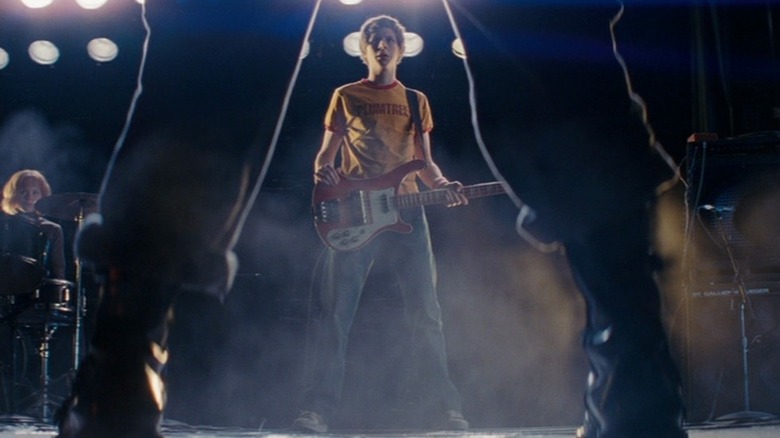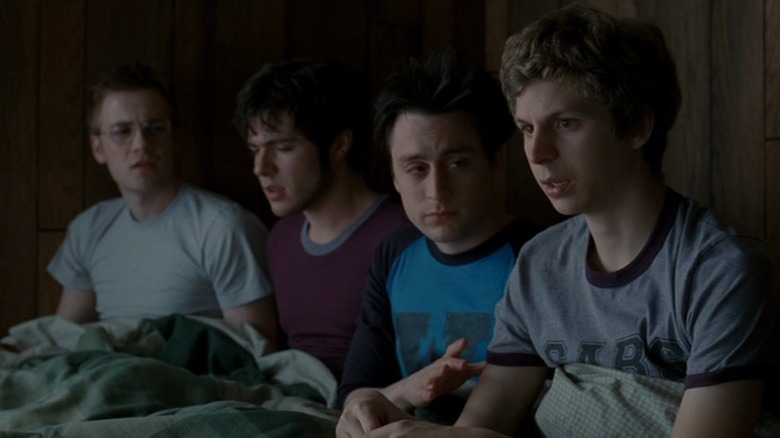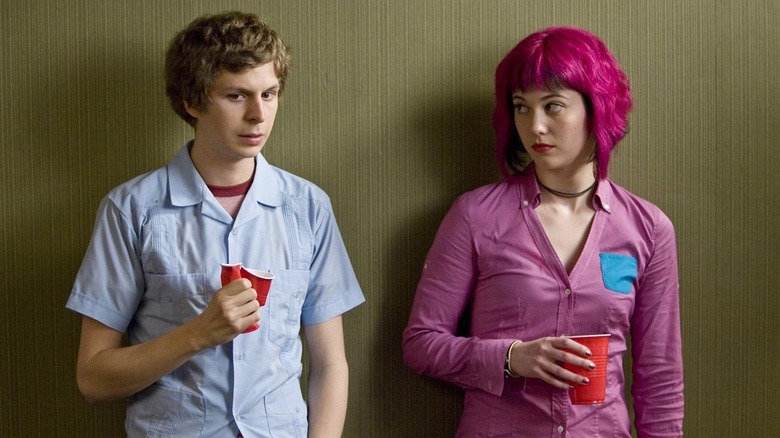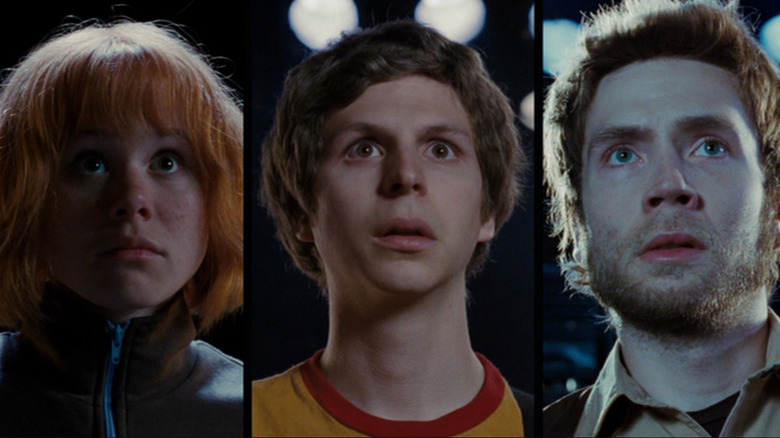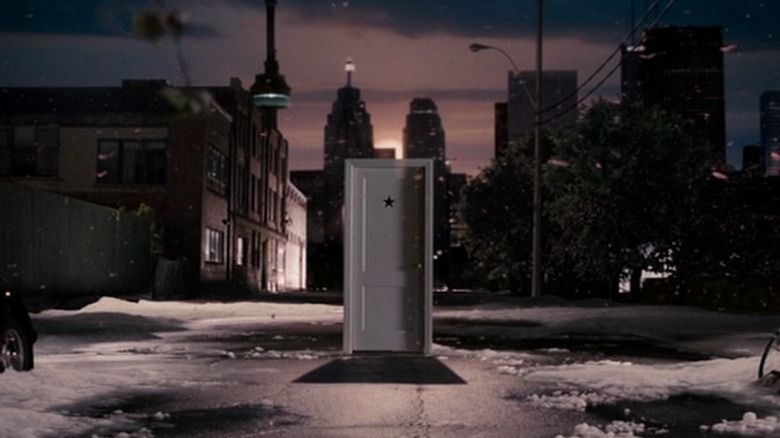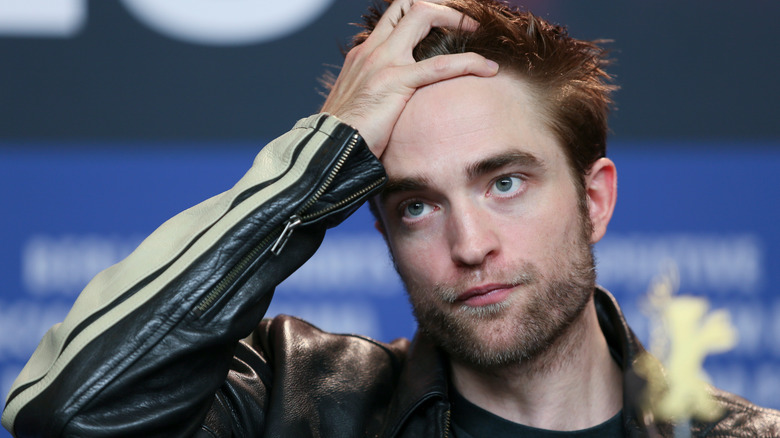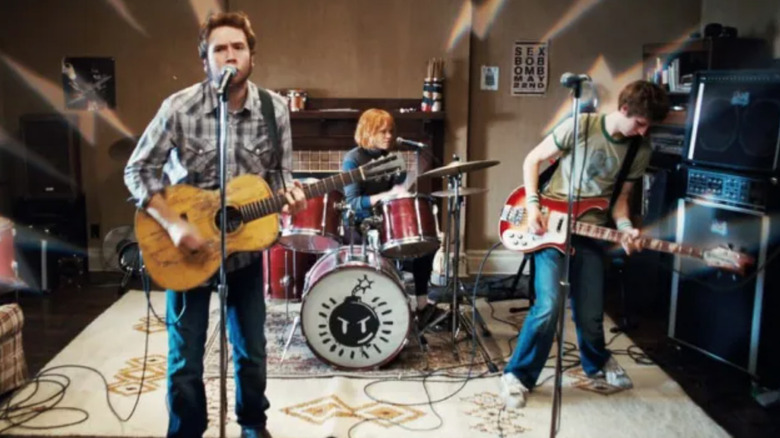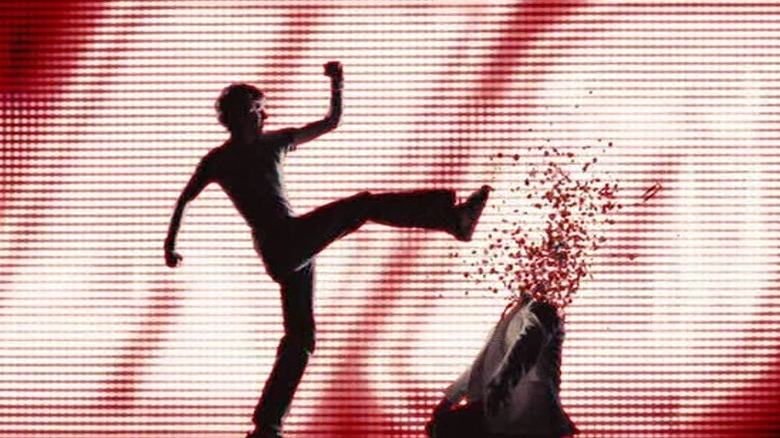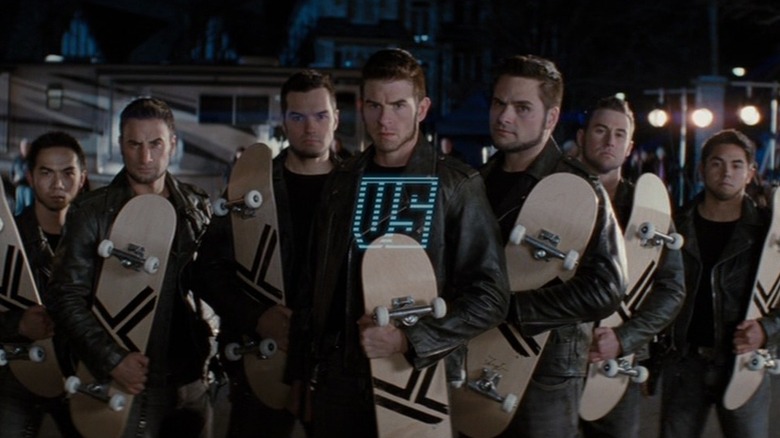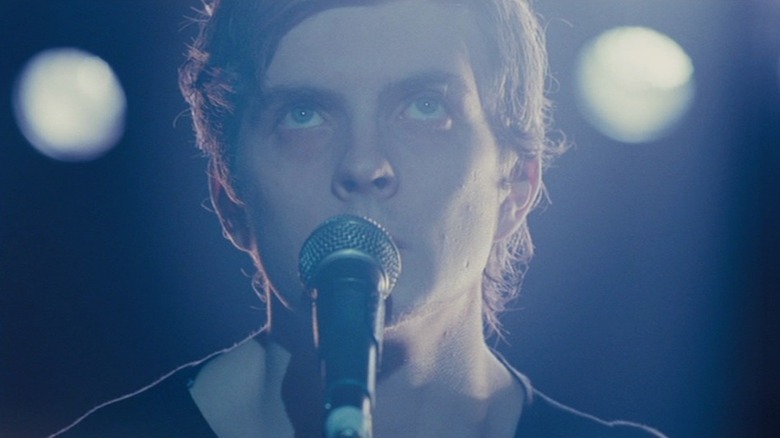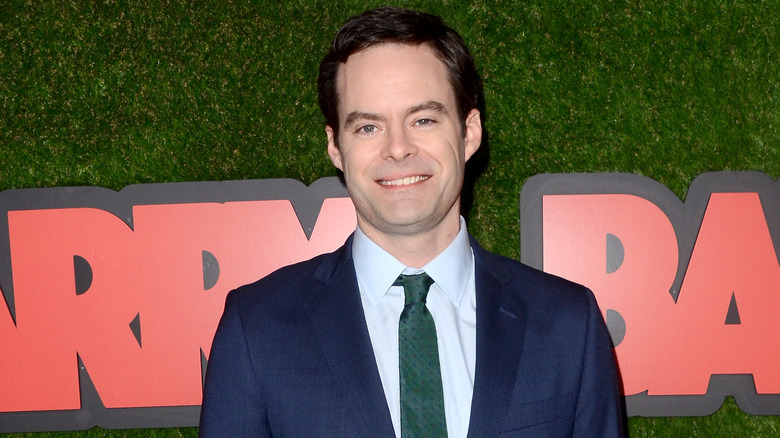Beat The Final Boss With These Scott Pilgrim Vs. The World Notes
Debuting in August 2010, "Scott Pilgrim vs. The World" was a blow across the chest of pop culture. Combining so many different mediums of artistic expression (video games, music, films, comics, etc.) into one propulsive action/comedy, the screen adaptation of Bryan Lee O'Malley's comics defied easy descriptions even by the standards of director Edgar Wright's masterfully idiosyncratic filmmaking. Though a box office flop, the uniqueness of "Scott Pilgrim vs. The World" has ensured it has endured in the public consciousness, to the point that several lines from the feature have now become common parlance among moviegoers of a certain age. The story's popularity has proved to be so enduring, in fact, that in 2023, Wright announced a brand new anime adaptation of "Scott Pilgrim," which will reunite the movie's cast.
"Scott Pilgrim vs. The World" is truly one of a kind. From Wright's perception on how key casting choices were made to what genre of filmmaking inspired the action sequences to even the film's unforgettable San Diego Comic-Con presence, the untold truth of "Scott Pilgrim vs. The World" further reinforces what a special movie this title has turned out to be.
Michael Cera was the only choice for Scott Pilgrim
Even with all the famous roles Michael Cera has inhabited, it's still difficult to separate him from his performance as Scott Pilgrim in "Scott Pilgrim vs. the World." Cera's distinctive film persona was just such a perfect fit for this character and his gift for timing means that he's responsible for the best line deliveries in the entire movie. Given how snugly he fits into this role, it shouldn't be a surprise that Edgar Wright always envisioned the part as being one that only Cera could portray.
"Michael was my first and only choice for the role," Wright explained to CinemaBlend in a 2010 interview. "I've been working on this for, like I said, five years and I remember in 2005 writing the first draft of the script and saying to (co-screenwriter) Michael Bacall — we were watching a lot of 'Arrested Development' at the time –- 'Oh, it's a shame that George Michael kid isn't older. He'd be perfect for Scott Pilgrim.' And then cut to 2010 and he's 22 and the character is 22 and we're all good." Wright also noted that another advantage to casting Cera in the part was how it was "fun, entertaining, novelty to see somebody who isn't an action star doing big action scenes. And as a sort of challenge, you know, can we get Michael Cera to a 'Kill Bill' level and stuff? That was it for me. And he was Canadian."
How Edgar Wright took to directing the ensemble cast
Edgar Wright movies often have tons of memorable supporting performances, with the likes of "Baby Driver" or "Hot Fuzz" being two-character stories chock full of unforgettable supporting figures. "Scott Pilgrim vs. the World," meanwhile, has the most packed cast of any Wright feature, with many of them getting developed far beyond just one-dimensional stereotypes. Working with so many performers at once could intimidate some filmmakers, but Wright embraced the chance to work with such a stacked ensemble cast.
"It was great. It's interesting," Wright remarked to CinemaBlend about working with all these actors. "I think with an ensemble — hopefully people watch the film more than once — you can actually start to watch the bit players. Like Kieran Culkin said a funny thing. He said, 'You can watch a completely different film if you just watch Johnny Simmons in every single shot.' Which is absolutely true! If you look at Johnny Simmons in the last shot in the film, which most people don't spot straight away, he does something so stupid in its final shot, and it makes me laugh every time. That's very true to the books. In the books, there's this kind of peanut gallery feel where there's things going on and nothing going on in the background, and the ensemble is always doing something in the books. I tried to pull that off in the film as well."
Edgar Wright wanted no British actors in the cast
"Scott Pilgrim vs. the World" is a departure from other Edgar Wright movies in several key ways, including that the project had a significantly bigger budget than prior Wright works like "Shaun of the Dead." However, another key departure from Wright's other films was that this British-born filmmaker was insistent that there were no British performers utilized in the cast.
"Because this is my first North American film and working with all American and Canadian actors, I actually said to the casting director, I didn't want any Brits doing American accents and I didn't want any British actors in the film," Wright said in a featurette, according to BBC America. "I wanted them to all be American or Canadian." Of course, European talent is so widespread in the acting community that someone from across the pond was bound to sneak onto the cast list for "Scott Pilgrim vs. the World."
"Satya Bhaba, which I found out after he was cast the film...not only is he from London, he also grew up like five minutes from where I live in London," Wright recalled. "So he completely fooled me in the audition, and, fair play to him, because he's fantastic in the film."
Ellen Wong doubted she'd get to play Knives Chau
One of the performances most critical to making "Scott Pilgrim vs. The World" work as well as it does is Ellen Wong's turn as Knives Chau. What could have been a passive performance, the forgettable "other girl" to the more prominent Ramona Flowers (Mary Elizabeth Winstead), becomes unforgettable in Wong's hands. What's especially impressive is that Wong makes sure Chau never lapses into being a mocking caricature. Even when she's having a breakdown over Scott Pilgrim seeing another, older woman, Wong injects a relatable quality into Chau's psyche that makes us fully understand her perspective. Given just how perfectly she inhabited this role, it can be shocking to hear that, initially, Wong was convinced she had no chance at securing the part.
"As an Asian actress, I was never going out for a role like this," Ellen Wong recalled to Entertainment Weekly. "This was not the type of role that I would be able to even look at." Thankfully, for the sake of the overall movie, Wong not only auditioned for "Scott Pilgrim vs. the World" but also scored the part of Knives, in the process ensuring this film would have one of its most important performances.
Wright was pleased with the prominence of women in Scott Pilgrim
"Scott Pilgrim vs. the World" has garnered varying degrees of responses to its approach regarding female characters. However, one objectively true fact about the film is that there are several women in the story beyond Scott Pilgrim's love interests Ramona Flowers and Knives Chau. Played by the likes of Brie Larson and Aubrey Plaza, among others, these characters and their comedic moments are some of Edgar Wright's favorite parts of this production.
"The thing I'm really pleased about with this film, as opposed to some of the other comedies out there — and even stuff I've done before — is that it has a lot of funny women in it," Wright told Collider. "Really a large part of the cast, and even the books are not just about his love life, but his exes and family, and friends. There's this one scene the other day that I would describe as 'the funny lady relay race' ... it's just Michael being attacked from all sides from all the different women in the film." Given how the characters played by performers like Plaza and Larson became some of the most beloved scene-stealers in "Scott Pilgrim vs. the World," it's a good thing Wright made time to shine the spotlight on multiple women in the film.
Bryan Lee O'Malley criticized the film's lack of diversity
While a widely acclaimed project, "Scott Pilgrim vs. the World" has, like any movie, not been without some criticism. Most notably, the film has been critiqued for its casting, which largely employed white actors. Among those who have registered grievances with this is Bryan Lee O'Malley, who penned the film's source graphic novels. An author of French-Canadian and Korean heritage, O'Malley has been open about his issues with the eventual casting of the "Scott Pilgrim vs. the World" movie.
"Honestly, when I saw the Scott Pilgrim movie it was kind of appalling to see just how white it was — to not even really see myself represented on the screen," O'Malley wrote on Radio Maru. "At least in the comic they were just cartoons. You can project yourself into a simple drawing of a person so easily; race seems to matter less (look at the global popularity of manga, where everyone is ostensibly Japanese)." He went on to note that the casting of this film was a key influence in his decision to add more diversity to his subsequent works like "Seconds." These comments reflect the complicated legacy of even movies as well-received as "Scott Pilgrim vs. the World."
Edgar Wright's dedication to authentic Canadian locales
American movies filmed in Canada are a dime a dozen, thanks to the country's charitable tax incentives. However, these productions usually use Canadian backdrops to double as other places, including famous American cities. "Scott Pilgrim vs. the World" departed from this norm by taking a cue from its source material and setting Scott's story in specific locations all across Toronto, Canada. To make sure he approached these backdrops properly, Edgar Wright did his homework and committed fully to understanding just where he'd be shooting "Scott Pilgrim vs. The World."
The Globe and Mail noted that "Scott Pilgrim vs. the World" was one of the biggest films to be set in Toronto up to that point. This feat was accompanied by Wright spending countless hours observing the terrain of Toronto and making sure "Scott Pilgrim" would utilize landmarks in the area. "The books are super-specific in their local details," producer Miles Dale explained. "And Edgar Wright, from the beginning, was set on using images from the books. Universal never suggested setting it anywhere else." Committing to this backdrop is emblematic of the specific details that make "Scott Pilgrim vs. the World" such a uniquely entertaining experience.
The hardest action scene to film
The assorted action sequences in "Scott Pilgrim vs. the World" are a masterful blend of visual and auditory elements that required a lot of effort to execute. But one particular action scene turned out to be the most challenging part of "Scott Pilgrim Vs. the World" to film. This was none other than the climactic showdown between Scott Pilgrim and Gideon Graves.
"We were raring along at this amazing pace," Edgar Wright recalled to Entertainment Weekly about the initial vibe during the film's principal photography. "And then there was this final set piece on a pyramid. Suddenly, we slowed down to doing 10 shots in a day, which is very slow for me. I sat there on top of this pyramid, looking down at these enormous platforms being maneuvered around and I thought, 'Whose idea was this?' And it was mine." While the scene itself proved to be exhilarating to watch unfold in a movie theater, it's apparent the complicated sets and choreography made it an enormous undertaking to actually shoot. Thankfully, for Wright and company, all of that effort ended up paying off handsomely since this climactic battle closed out "Scott Pilgrim vs. the World" on an exciting high note.
How that title sequence came about
From the very start, "Scott Pilgrim vs. the World" makes it apparent you're going to watch something special when a performance from the band Sex Bob-omb triggers a visually aggressive opening credits sequence. The names of key cast and crew members are displayed against frantic animation and a wave of colors that clue the viewer in on the kind of visually unpredictable and audacious movie they're about to absorb.
In breaking this sequence down for The Art of the Title Sequence, Edgar Wright revealed several fascinating facets of this segment, including that its very existence came at the suggestion of Quentin Tarantino after the "Pulp Fiction" director saw an early screening of the film. The artists in charge of crafting these opening credits also had to come up with their own unique visuals — they couldn't draw from imagery in either the film itself or the "Scott Pilgrim" graphic novels. It took an enormous amount of effort and craft to pull off such an unusual approach to an opening credits sequence, but the result was something that made "Scott Pilgrim vs. the World" a captivating experience right from the start.
Musicals inspired the action sequences
Music plays a big part in "Scott Pilgrim vs. the World." How could it not? After all, Scott plays in a band called Sex Bob-omb and so many of the film's big action scenes begin with bands performing on stage. But music's influence in this film was not just limited to in-universe performances. The world of musicals also had a significant influence on how Edgar Wright composed the various major action set pieces.
"We thought it should play out like a musical in a way, in terms of the fights are not dissimilar to the songs," Wright said to Collider about the action scenes. "I always thought there were a lot of martial arts films that were like musicals, so we wanted to take that further. Ya know, in a Gene Kelly film when he performs an amazing routine, at the end of the scene no one goes, 'Oh my god, that was f***ing amazing!' The song is about something, and then there might be some dialogue at the end that is also about that theme. And that's kind of how this works where people have these huge fights — and it's kind of like how it is in the books — where everything goes back to normal, and there's a little reaction to what just happened, but there's no sort of mourn the dead."
Coping with Scott Pilgrim's box office shortcomings
In the aftermath of "Scott Pilgrim vs. The World" failing to take the box office by storm, the conversation inevitably turned to what went wrong. One recurring answer as to how such an acclaimed film failed to click with audiences was to look at the film's marketing, which many deemed lackluster and a key culprit in the box office performance. Of course, those who made the film have their own thoughts as to what it was like to advertise such an unorthodox title.
"After the film didn't open well, I realized the thing to do is to take responsibility for it but also just believe in the fact that it was a good film and people would find it eventually," Edgar Wright told Entertainment Weekly in 2020 for the movie's 10th anniversary. "The worst thing you can do [is] the blame game, after the weekend. 'It's something else's fault.' 'It was the day.' 'It was the poster.' 'Oh, the studio decided to do this.' I never did that. Even though people in interviews were always asking me, 'Do you think the marketing was the thing? Or do you think the poster?' The thing is, I realized that it was a film that was difficult to sum up in one sentence. But obviously it was tough at the time."
That iconic Comic-Con panel
"Scott Pilgrim vs. the World" was a movie made by nerds for nerds. So it shouldn't be a surprise that the movie didn't just have a presence at the 2010 San Diego Comic-Con, but was screened in its entirety right after its panel. Even before the film itself was shown though, the panel in the San Diego Convention Center's cavernous Hall H turned out to be one for the ages with its many surprises. These included the presence of former Edgar Wright leading men Simon Pegg and Nick Frost, plus several memorable moments, such as Michael Cera coming out in a Captain America costume – a nod to "Captain America: The First Avenger," which was also showing off footage at the event.
The whole event became so packed with excitement that the Associated Press ran a piece on the event with the headline "Scott Pilgrim Creates Comic-Con Pandemonium." Looking back on that Comic-Con panel, the film's creative participants have nothing but good memories. "That was a huge experience for me," Mary Elizabeth Winstead recalled to Entertainment Weekly. "I had been to Comic-Con before a couple of times, but it was such a bigger version of it when we went for 'Scott Pilgrim.' It just felt like a huge deal. At Comic-Con it felt like it was the biggest film of all time."
The actors rarely blink
From the very start of his career, Edgar Wright has always made it clear that he's a highly stylistic director. His films are full of intense energy, flashy visuals, unique flourishes, clever transitions, and meticulous attention to detail. When he crossed the pond for his first North American production, Wright brought his signature style of filmmaking along — and then went one step further.
One of the wildest creative decisions made in "Scott Pilgrim vs. the World" was to prevent the actors from blinking on camera. Most directors wouldn't presume to control the involuntary bodily functions of their cast, but for Wright, it's all part of the film's overall aesthetic. Blinking isn't something the characters in the comics have to contend with, so their live-action counterparts don't blink either. Wright didn't outlaw blinking entirely; instead, he designated specific moments when the actors were allowed to blink that would suit the film's stylistic and comedic intent. If an actor accidentally blinked when they weren't supposed to, that was cause to start the take over from the top. Anna Kendrick described being required to do one particular shot over and over again, because it was difficult to get through without blinking. The effect of Wright's no-blinking rule in the finished film is something that may or may not be noticed by any given viewer, but it might affect the viewing experience on a subconscious level, if nothing else.
The poorly received original ending
When "Scott Pilgrim vs. the World" first went into production, the comic series hadn't yet been brought to its conclusion. There are six volumes total in the "Scott Pilgrim" comic series, but co-writers Edgar Wright and Michael Bacall began working on their adapted screenplay when the comics had progressed no farther than volume four. In fact, at this point, cartoonist Bryan Lee O'Malley hadn't even decided how the comic series was going to end. This meant that although much of the film's story was adapted directly from the source material, everyone was working without a roadmap when it came to crafting the ending.
The ending Wright and Bacall landed on was to have Scott Pilgrim get back together with Knives Chau while Ramona Flowers went off on her own. This ending proved divisive amongst test audiences, and O'Malley was against it as well, mostly because he felt it made Knives a weaker character and it was important to him that she grew beyond Scott. O'Malley, Wright, and Bacall worked together to craft an ending that enabled Scott and Knives to grow and Scott and Ramona to still wind up together. The have-your-cake-and-eat-it-too ending worked out brilliantly and became the official ending. The original ending can still be found in the special features of physical media releases and on YouTube.
Robert Pattinson auditioned for the movie
In an alternate timeline, Robert Pattinson could have played the egomaniacal movie star Lucas Lee instead of Chris Evans. Pattison auditioned for the part, and, according to Edgar Wright, offered a good but far more intense spin on the role. They ultimately went with Evans instead, who put a more goofy spin on things.
"Scott Pilgrim vs. the World" was released in 2010, two years after the first "Twilight" movie turned Pattinson into a superstar. But auditions for Wright's film were already underway before "Twilight" hit theaters. Chris Evans was more of an established name, having already starred in big movies like "Push" and "Fantastic Four," though he was far from reaching his zenith. Just one year later, Evans made his entry into the MCU with "Captain America: The First Avenger." Even though he apparently auditioned with a flawless American accent, Pattinson's status as a Brit may have counted against him, given Wright's no-British policy for his first North American production. Coming from the same country as Wright might have dashed Pattinson's chances before he even delivered his first line.
The music was pulled directly from the comics
"Scott Pilgrim vs. the World" is packed with original music. The titular character plays some of it himself via his role as bass player in his band, Sex Bob-Omb. Many other original songs are played by competing musical groups Crash and the Boys, the Katayanagi Twins, and The Clash at Demonhead, which is led by Scott's ex, Envy Adams.
Given the difference in medium between printed comics and movies, you might assume each band's music had to be created specifically for the film. But this wasn't exactly the case. Series creator Bryan Lee O'Malley went above and beyond when it came to the depicting the comic's tunes, and did much of the leg work necessary to translate the music to the silver screen. The song lyrics are printed as dialogue, and some of the music is composed in full right on the page. Before the film adaptation, fans of the comic were already able to hear the intended soundtrack, so long as they had the dedication and talent necessary to read the comic's tabs and sheet music.
O'Malley's comic compositions provided the basis of the film's soundtrack, but other musicians also got involved. This group included Beck, Broken Social Scene, and Nigel Godrich, who brought the full "Scott Pilgrim" soundtrack to life while keeping it in line with O'Malley's original roadmap.
The Scott Pilgrim game that became impossible to play
"Scott Pilgrim vs. the World: The Game" came out alongside the film adaptation — just three days earlier, in fact. The game keeps the art style of the comics intact and plays as a 2D side-scrolling beat 'em up. With all of the video game references in "Scott Pilgrim," it's perfectly fitting that the IP was given the video game treatment. But after its initial release, the game suddenly became impossible to get ahold of, and would remain that way for a number of years. "Scott Pilgrim vs. the World: The Game" was never released as physical media, and could only be purchased via digital storefronts. The trouble came when the title was delisted from every storefront, much to the chagrin of gamers everywhere — as well as comic creator Bryan Lee O'Malley.
After floating around in the video game ether for about six years, Ubisoft finally re-released the game in 2020 as the "Complete Edition," which includes downloadable content that was previously sold separately. Without the vocal outcry from gamers who were upset by the game's complete unavailability, it might never have been re-released. The franchise will continue to grow larger in the near future with the new "Scott Pilgrim" anime series headed to Netflix. Hopefully, no more delistings are in the future.
The complex special effects required extreme ingenuity
"Scott Pilgrim vs. the World" is packed with special effects. VFX are used for its video-game-inspired graphics and over-the-top fight scenes, as you might expect, but they're also incorporated in subtler ways, such as snow added to distant rooftops. Simultaneously, Edgar Wright resisted using VFX in some instances where it would have made the production significantly easier. The biggest example of this is when he tasked Michael Cera with tossing a package over his shoulder into a trash can without looking. This likely could have been a quick one-and-done shot with the aid of simple VFX or camera trickery, but Wright insisted on doing it for real. Accomplishing this feat wound up taking Cera 33 attempts, all of which can be seen in the film's blooper reel.
Other moments required a complex blend of different VFX types. The moment when Lucas Lee hurls Scott Pilgrim into the side of a castle was executed by having actor Chris Evans throw a dummy, which was replaced in post-production with a digital double of Cera. The dazzling effect where slain opponents explode into coins presented a particularly unique challenge. Scott Pilgrim's opponents couldn't be filmed in the same place at the same time. So, Cera and his stunt double were filmed swinging the hilt of a sword at imaginary enemies. Later on, the enemies were comped into the paths of his swings and the sword hilt was digitally extended into a longer, flaming blade, which could pass directly through the enemies as they exploded into currency.
The actors did some of their own stunts
Stunt doubles were utilized throughout the production of "Scott Pilgrim vs. the World," but the non-stunt cast got physical too. Most people probably don't think of fighting and action when they think of Michael Cera, but he did more of his own fight choreography than you might realize, as can be seen in the film's behind-the-scenes featurettes. Other members of the cast, like Chris Evans and Satya Bhabha, did a significant amount of their own fighting, stunts, and wirework as well. Funniest of all, even though his character makes use of numerous stunt doubles in his big fight scene, Chris Evans did most of his character's fighting himself. He even did the skateboard jump onto the railing for real.
The action you see on screen is a seamless blend of the real cast, their stunt doubles, and CGI doubles. Throughout his career, Wright has made frequent use of a filmmaking technique known as the Texas switch. The Texas switch is when the actor and their stunt double tag out and appear in the same shot at different points to really sell the illusion. "Scott Pilgrim vs. the World" is chock-full of creative Texas switches, such as the shot where a stunt double takes a nasty fall down some scaffolding and the real Michael Cera rolls into frame at the end. A CGI double is used to hide the transition between the two.
A deleted extra song
The original soundtrack is key to "Scott Pilgrim vs. the World," so it might come as a shock to learn that there was one extra original song that wound up on the cutting room floor. The bonus song is titled "Last Song Kills Audience" and comes courtesy of Crash and the Boys, one of the fictional bands that Sex Bob-Omb faces in the Battle of the Bands. Just like the other songs from this fictional band — you might remember "We Hate You, Please Die" — it's short, blunt, and mostly played for the joke of the title.
With a final runtime of one hour and 52 minutes, there was nearly half an hour's worth of additional deleted scenes that didn't make the cut. Some of the most notable excised sequences include Ramona kicking Scott out the morning after their first night together and multiple appearances from Nega-Scott ahead of his full emergence at the climax of the film, which wound up becoming the first time audiences see him in the theatrical cut. Scott and Ramona's first date and the fight scene between Ramona and Roxy Richter were also significantly longer in the original cut.
Bill Hader has a super secret cameo
The most subtle cameo from a big-name celebrity that was snuck into "Scott Pilgrim vs. the World" is undoubtedly Bill Hader's. If you're a huge fan of Hader and "Scott Pilgrim" and are wondering how you could have missed an appearance from him, even after multiple watches, it's because he never actually appears in person.
Hader might not be visible on screen, but his voice can be heard multiple times. At key moments in the film, a disembodied video game-style narrator chimes in, intoning lines like, "Scott earned the power of self-respect!" As you might expect, the lines he delivers mostly come from the disembodied text of the comics. Though Hader slightly disguises his voice, once you know it's him, you can discern his familiar tone. For a long time, this cameo went largely unnoticed. But it eventually gained a profile boost when Edgar Wright pointed it out on Twitter on the film's 10-year anniversary. It should be noted, though, that Wright actually let this cameo slip on Twitter before the movie was even released, all the way back in 2010.
Stacey Pilgrim is based on a real person
Anna Kendrick played the supporting role of Stacey Pilgrim, the titular character's younger sister, in "Scott Pilgrim vs. the World." When Bryan Lee O'Malley was first making the comic book, long before there was any notion of adapting it into a film, he based many characters on real people from his life. For Stacey, O'Malley turned to his real-life sister for inspiration.
The real-world Stacey Pilgrim actually is named Stacey, and she really did work at a Second Cup coffee shop. As movie fans know, the character and coffee shop both survived the page-to-screen adaptation intact. The real Stacey was even present on set, and was initially supposed to be in one of the coffee shop scenes. Her cameo didn't end up working out, but it might still be possible to spot her in the background as an extra. She also gave Kendrick her real "certified coffee agent" name tag from her time at the Second Cup to use in the film.
